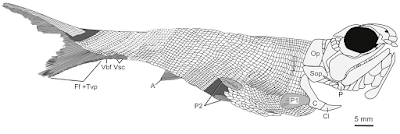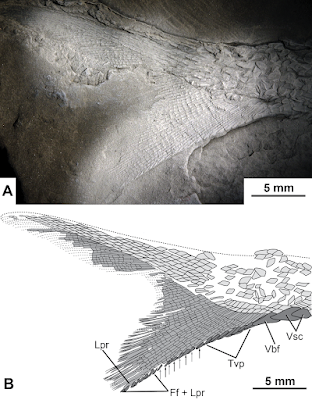 |
| Bluefieldius mercerensis Mickle, 2018
DOI: 10.7717/peerj.5533
|
Abstract
The Upper Mississippian Bluefield Formation of the Mauch Chunk Group in southeastern West Virginia is known for its preservation of a variety of invertebrate taxa and early tetrapod trackways, but no lower actinopterygian remains have been formally described from these Carboniferous rocks. Here, the first lower actinopterygian fish is described from the Bluefield Formation of West Virginia. This fish is represented by a nearly complete articulated specimen with a three-dimensional snout and an unobstructed view of the gular and branchiostegal region. This new taxon is defined by a unique set of characters, which include features of the snout, circumorbital series, cheek, and operculo-gular region. These features make this fish different and distinct from previously described Carboniferous fishes. Some of the morphological features of note include the presence of a distinct lacrimal, premaxillary, ventral rostral and dorsal rostral bones, a narrow infraorbital ventral to the orbit, and a large crescent shaped infraorbital that contacts a single dermosphenotic. There is an anteriorly inclined hatchet-shaped preoperculum and six small suborbital bones anterior to the expanded region of this bone that filling the space between the preoperculum, dermosphenotic, and infraorbital. Posterior to the preoperculum, there is a single wedge-shaped dermohyal and a series of three rectangular anteopercular bones. The anteopercular bones extend halfway down the anterior border of the rectangular operculum. A median gular, two pairs of lateral gulars, and at least eight branchiostegal rays are present. The heterocercal caudal fin is deeply cleft and inequilobate. The scales have pectinated posterior margins and bear diagonal ridges of ganoine. The description of this new taxon represents the first actinopterygian and the first vertebrate body fossil described from the Bluefield Formation and the second actinopterygian taxon described from the Mauch Chunk Group in West Virginia.
Systematic paleontology
OSTEICHTHYES Huxley, 1880
ACTINOPTERYGII Cope, 1871
Bluefieldius n. gen.
Type and only Species. Bluefieldius mercerensis n. gen. n. sp
Etymology. After the Bluefield Formation where the specimen was recovered from.
Bluefieldius mercerensis n. gen. n. sp.
Etymology. mercerensis in reference to Mercer County, West Virginia where the specimen was recovered.
Diagnosis. Based on the unique combination of the following characters: Absence of complex bones in the snout and the presence of distinct and separate lacrimal, premaxillary, and dorsal and ventral rostral bones; narrow rectangular infraorbital ventral to the orbit; large crescent shaped infraorbital posterior and posteroventral to the orbit that contacts a single Y-shaped dermosphenotic dorsally; six small rectangular suborbital bones arranged in two distinct rows; wedge-shaped dermohyal posterior to a hatchet-shaped preoperculum; a row of three rectangular, ganoine-bearing anteopercular bones that extend down half the depth of the operculum; rectangular anteriorly inclined operculum with a diagonal ventral margin, suboperculum that is taller posteriorly than anteriorly and shorter in height but wider in length than the operculum; maxilla with a deep posterior plate, a rounded posteroventral process, and a narrow anterior arm that extends to the anteroventral margin of the orbit; a single median gular, two pairs of lateral gulars, a series of at least eight branchiostegal rays; inequilobate and deeply cleft heterocercal caudal fin with an elongated caudal peduncle; anteriorly placed and mid-body scales with pectinated posterior margins and diagonal ridges of ganoine.
Conclusions:
A new lower actinopterygian genus and species is described from the Upper Carboniferous Bluefield Formation of West Virginia. This new genus is represented by a well preserved articulated specimen which represents the first vertebrate body fossil from the Bluefield Formation and the first described actinopterygian. Bluefieldius mercerensis n. gen. n. sp. is defined by a unique set of cranial characteristics including morphological characters of the snout, the circumorbital series, suborbital bones, and anteopercular bones. The combination of these specific characteristics separate B. mercerensis n. gen. n. sp. from previously described lower actinopterygian fishes and warrant the description of a new taxon.
Lower actinopterygian fishes are characterized by a great deal of anatomic and taxonomic diversity that is not well understood. We have neither a stable classification scheme nor strongly supported hypotheses of relationships for lower actinopterygian fishes. This lack of understanding has been attributed to the need for more well-preserved fishes to be described or redescribed and a better understanding of morphological characters among lower actinopterygians (Cloutier & Arratia, 2004; Mickle, 2015; Mickle, 2017). Taxonomic work provides opportunities to uncover new morphological characters or to see characters in different light and can lead to reassessments of morphological characters. These taxa and characters are the raw material for phylogenetic analyses and more well described taxa and characters will bring stronger hypotheses of relationships for these important fishes.
Kathryn E. Mickle. 2018. A New Lower Actinopterygian Fish from the Upper Mississippian Bluefield Formation of West Virginia, USA. PeerJ. 6:e5533. DOI: 10.7717/peerj.5533


